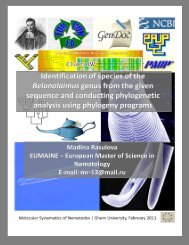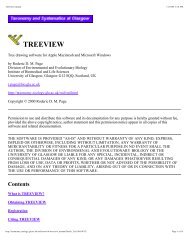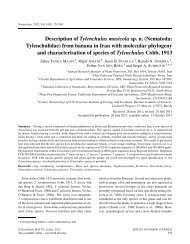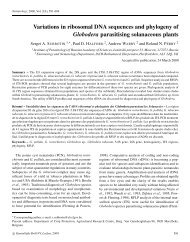Identification of cyst forming nematodes of the genus Heterodera ...
Identification of cyst forming nematodes of the genus Heterodera ...
Identification of cyst forming nematodes of the genus Heterodera ...
You also want an ePaper? Increase the reach of your titles
YUMPU automatically turns print PDFs into web optimized ePapers that Google loves.
S.A. Subbotin et al.<br />
H. schachtii, H. goettingianaand H. zeae (Szalanski et al.,<br />
1997). With <strong>the</strong> same technique, Subbotin et al. (1997)<br />
differentiated species from <strong>the</strong> H. humuli group, whereas<br />
Bekal et al. (1997) and Subbotin et al. (1999b) separated<br />
species within <strong>the</strong> H. avenae group, and Orui (1997) and<br />
Fleming et al. (1998) some o<strong>the</strong>r <strong>cyst</strong> <strong>nematodes</strong>.<br />
In <strong>the</strong> present paper we report on <strong>the</strong> use <strong>of</strong> rDNA<br />
RFLP in distinguishing <strong>Heterodera</strong> species, on <strong>the</strong> creation<br />
<strong>of</strong> species-speci c digestion pro les, and on our<br />
study <strong>of</strong> <strong>the</strong> variation <strong>of</strong> RFLP patterns between populations<br />
<strong>of</strong> some species.<br />
Materials and methods<br />
NEMATODE ISOLATES<br />
The present study comprised 25 valid <strong>Heterodera</strong><br />
species (Table 1) all identi ed by <strong>the</strong>ir morphology and<br />
morphometrics. One <strong>Heterodera</strong> population collected<br />
from Cynodon dactylon and similar to H. cardiolata was<br />
also included. To determine <strong>the</strong> degree <strong>of</strong> intraspeci c<br />
variation some <strong>of</strong> <strong>the</strong> species were represented by several<br />
populations. The species were categorised into four<br />
groups: H. avenae, H. schachtii, H. humuli and H. goettingiana<br />
according to <strong>the</strong> criteria and classi cations <strong>of</strong> Ma<strong>the</strong>ws<br />
(1971), Baldwin and Mundo-Ocampo (1991), and<br />
Wouts and Sturhan (1995). The H. avenae group was fur<strong>the</strong>r<br />
split into two subgroups: H. avenae sensu stricto and<br />
H. latipons. The H. schachtii group contained a subgroup<br />
H. schachtii s. str. composed <strong>of</strong> H. schachtii, H. trifolii,<br />
H. glycines, H. ciceri, and H. medicaginis. Previously obtained<br />
RFLP data <strong>of</strong> populationsfrom <strong>the</strong> H. humuli group<br />
(Subbotin et al., 1997) and <strong>the</strong> H. avenae group(Subbotin<br />
et al., 1999b) were included in <strong>the</strong> analysis. Two populations<br />
<strong>of</strong> Meloidodera alni were used for comparison.<br />
SAMPLE PREPARATION<br />
For each population, one to four <strong>cyst</strong>s were transferred<br />
into 10 ml <strong>of</strong> double distilled water in an Eppendorf<br />
tube and crushed with a microhomogenisator. Eight ml <strong>of</strong><br />
nematode lysis buffer (125 mM KCl, 25 mM Tris-Cl pH<br />
8.3, 3.75 mM MgCl2, 2.5 mM DTT, 1.125% Tween 20,<br />
0.025% gelatine) and 2 ml <strong>of</strong> proteinase K (600 mg/ml)<br />
were added. The tubes were incubated at 65 ° C (1 h) and<br />
95 ° C (10 min) consecutively.<br />
PCR REACTION<br />
After centrifugation (1 min; 16 000 g) 10 m l <strong>of</strong> <strong>the</strong><br />
DNA suspension was added to <strong>the</strong> PCR reaction mixture<br />
containing 10 ml 10X Taq incubation buffer, 20 ml<br />
5X Q-solution, 200 m M <strong>of</strong> each dNTP (Taq PCR Core<br />
Kit, Qiagen, Germany), 1.5 mM <strong>of</strong> each primer (syn<strong>the</strong>sised<br />
by Life Technologies, Merelbeke, Belgium), 0.8U<br />
Taq Polymerase (Taq PCR Core Kit, Qiagen, Germany)<br />
and double distilled water to a nal volume <strong>of</strong> 100 m l.<br />
Primers AB 28 (5 ¢ -ATATGCTTAAGTTCAGCGGGT-3 ¢ )<br />
and TW 81 (5 ¢ -GTT-TCCGTAGGTGAACCTGC-3 ¢ ) as<br />
described by Joyce et al. (1994) were used in <strong>the</strong> PCR<br />
reaction. The DNA-ampli cation pro le carried out in a<br />
GeneE (New Brunswick Scienti c, Wezembeek-Oppem,<br />
Belgium) DNA <strong>the</strong>rmal cycler consisted <strong>of</strong> 4 min 94 ° C;<br />
35 cycles <strong>of</strong> 1 min 94 ° C, 1.5 min 55 ° C, and 2 min 72 ° C;<br />
followed by a nal elongation step <strong>of</strong> 10 min 72 ° C. After<br />
DNA ampli cation, 5 ml product was run on a 1% agarose<br />
gel. The remainder was stored at 20 ° C.<br />
RFLP<br />
Five to 7 m l <strong>of</strong> each PCR product was digested with<br />
one <strong>of</strong> <strong>the</strong> following 26 restriction enzymes: AluI, AvaI,<br />
BamHI, BglI, BsiZI, BsuRI, Bsh1236I, Bsp143I, CfoI,<br />
DdeI, EcoRI, HpaII, HindIII, HinfI, KpnI, MvaI, PstI,<br />
PvuII, RsaI, SalI, SfuI, SspI, ScrFI, TaqI, Tru9I, and XbaI<br />
in <strong>the</strong> buffer stipulated by <strong>the</strong> manufacturer. The digested<br />
DNA was loaded on a 1.5% agarose gel, separated by<br />
electrophoresis (100V, 2.5 h), stained with ethidium bromide,<br />
visualised on a 2011 Macrovue UV transilluminator,<br />
and photographed with a Polaroid MP4+ Instant<br />
Camera System. Procedures for obtaining PCR ampli ed<br />
products and endonuclease digestion <strong>of</strong> <strong>the</strong>se products<br />
were repeated several times to verify <strong>the</strong> results. Poorly<br />
visible fragments less than 100 bp and some weak additional<br />
restriction fragments have not been taken into account.<br />
Results<br />
Ampli cation <strong>of</strong> <strong>the</strong> rDNA-ITS regions with <strong>the</strong> present<br />
primers was successful for all species. Most species yielded<br />
a single fragment <strong>of</strong> approximately 1060 bp. However,<br />
<strong>the</strong> PCR ampli ed product <strong>of</strong> H. cyperi was near 1100 bp<br />
and that <strong>of</strong> H. oryzicola near 1010 bp. No PCR products<br />
were obtained in <strong>the</strong> negative control lacking DNA template.<br />
154 Nematology
















